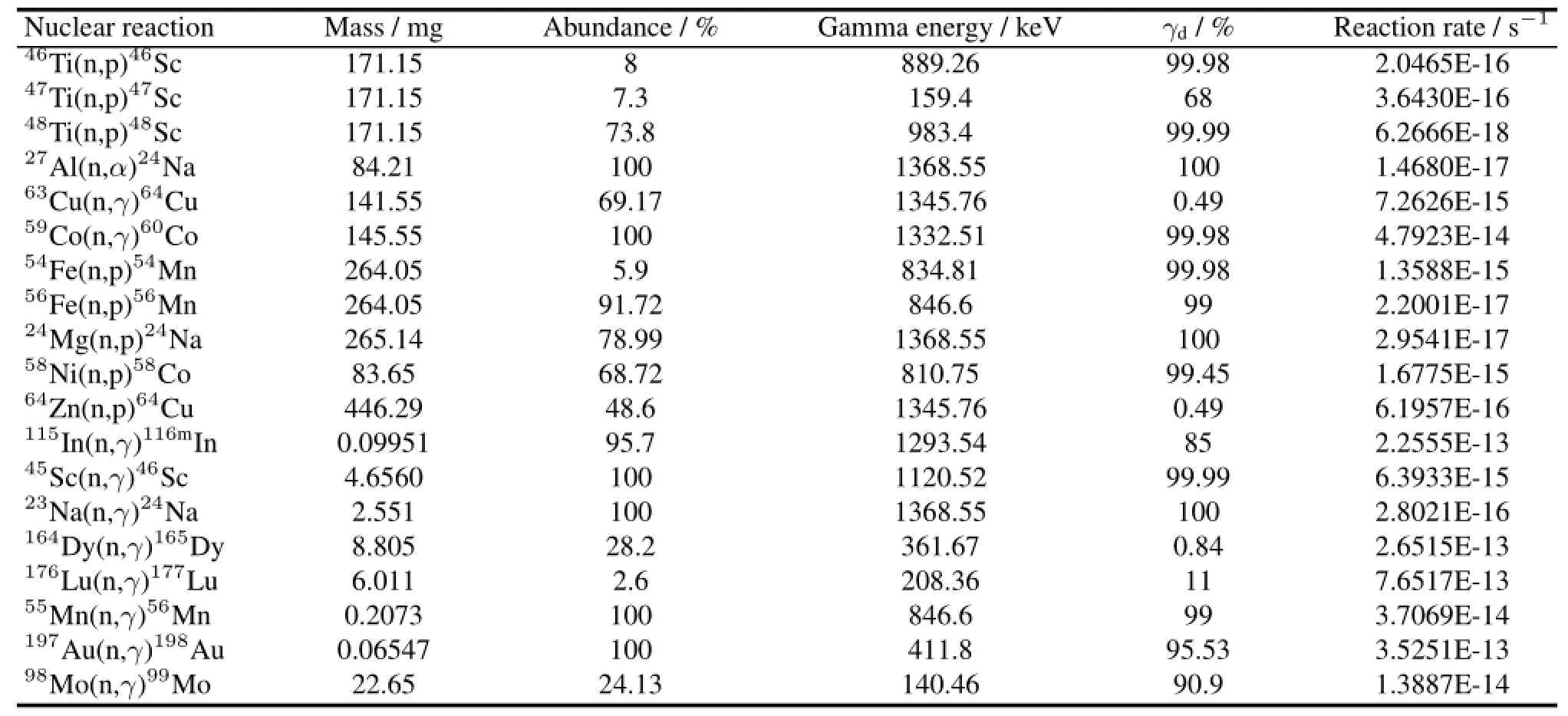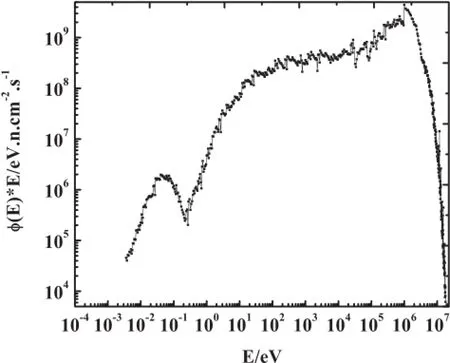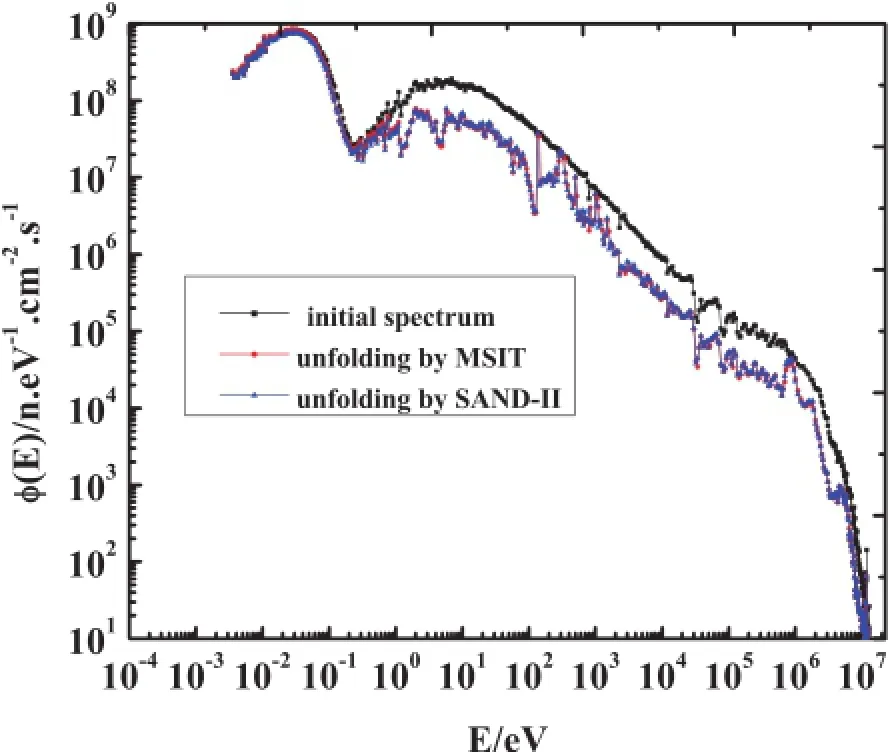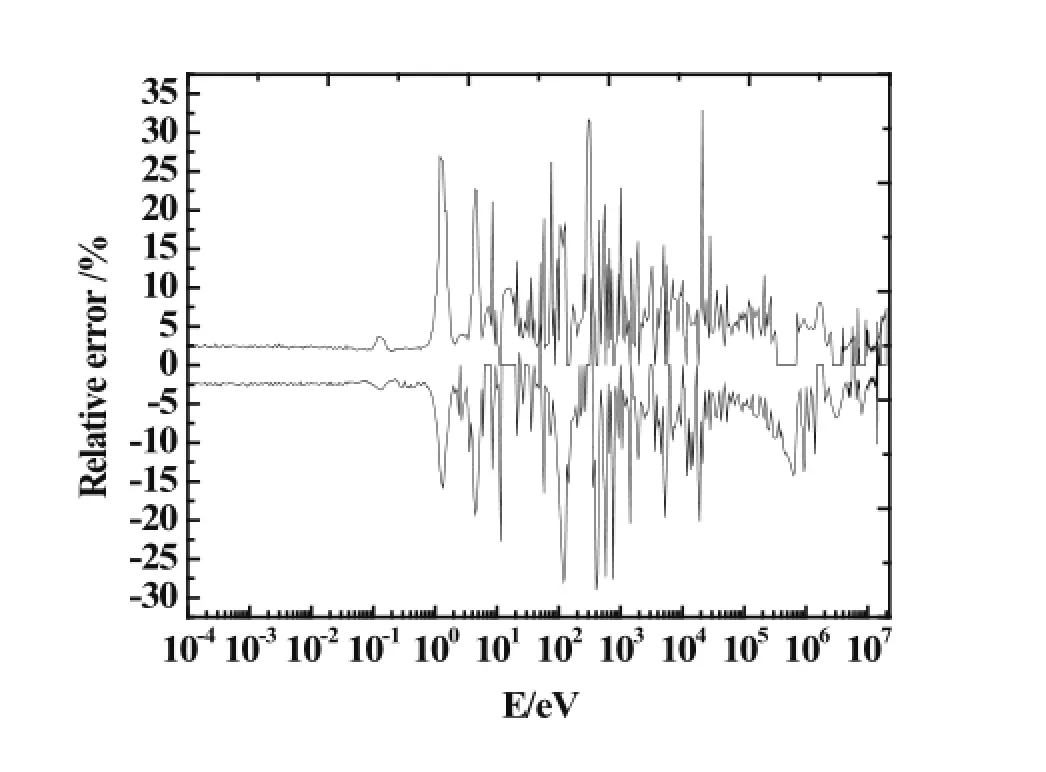Using activation method to measure neutron spectrum in an irradiation chamber of a research reactor∗
2014-04-24ZHOUXueMei周雪梅LIUGuiMin刘桂民LIDa李达WANGXiaoHe王小鹤andMENGLingJie孟令杰
ZHOU Xue-Mei(周雪梅),LIU Gui-Min(刘桂民),LI Da(李达),WANG Xiao-He(王小鹤),and MENG Ling-Jie(孟令杰),2
1Shanghai Institute of Applied Physics,the Chinese Academy of Sciences,Shanghai 201800,China
2Key Laboratory of Nuclear Radiation and Nuclear Energy Technology, Chinese Academy of Sciences,Shanghai 201800,China
3University of Chinese Academy of Sciences,Beijing 100049,China
4Northwest Institute of Nuclear Technology,Xi’an 710024,China
Using activation method to measure neutron spectrum in an irradiation chamber of a research reactor∗
ZHOU Xue-Mei(周雪梅),1,2,3,†LIU Gui-Min(刘桂民),1LI Da(李达),4WANG Xiao-He(王小鹤),1and MENG Ling-Jie(孟令杰)1,2
1Shanghai Institute of Applied Physics,the Chinese Academy of Sciences,Shanghai 201800,China
2Key Laboratory of Nuclear Radiation and Nuclear Energy Technology, Chinese Academy of Sciences,Shanghai 201800,China
3University of Chinese Academy of Sciences,Beijing 100049,China
4Northwest Institute of Nuclear Technology,Xi’an 710024,China
Neutron spectrum should be measured before test samples are irradiated.Neutron spectrum in an irradiation chamber of a research reactor was measured by using activation method when the reactor is in normal operation under 2MW.Sixteen kinds of non-f i ssion foils(19 reaction channels)were selected,of which 10 were sensitive to thermal and intermediate energy regions,while the others were of different threshold energy and sensitive to fast energy regions.By measuring the foil radioactivity,the neutron spectrum was unfolded with the iterative methods SAND-II and MSIT.Finally,shielding corrections of group cross-section and main factors affecting the calculation accuracy were studied and the uncertainty of solution was analyzed using the Monte Carlo method in the process of SAND-II.
Neutron spectrum,Iterative method,SAND-II,MSIT,Group cross-section
I.INTRODUCTION
Most neutrons in Irradiation Chamber 3 of the research reactor are intermediate and fast neutrons,because most thermal neutrons are stopped in the lead box.Many samples can be irradiated in the irradiation chamber.Measuring neutron spectrum at the irradiation point can provide important information for irradiation experiments[1].
Activation method is a simple and widely used method for measuring neutron energy spectrum[2–4].The foil size is small enough to ensure a uniform neutron f i eld at the measuring point.Different foil materials can measure neutrons in different energies.Activation method depends greatly on the spectrum unfolding technology.In recent years,many unfolding methods have been developed.They can be divided into three classes:[5,6]iteration method,method of undetermined coeff i cients,Monte Carlo method.The method of undeterminedcoeff i cientswasoncewidelyused,butitproducesrough results.Monte Carlo method dealing with a large number of neutron energy groups shall request great deal of computation time,while reliability of the results is poor when fewer number of activation foils was chosen.In recent years,with the development of computer technology and the improvement of the cross section library,iteration method has been widely used, with much more accurate results.SAND-II and MSIT are both iteration methods.In this work,MC uncertainty analysis was added to SAND-II,so as to obtain even better results.
II.THEOETICAL ANALYSIS
A.The fundamental procedures of activation method
The fundamental of activation method for measuring neutron spectrum is as follows:a group of foils,with known activation of sections of the nuclides,are irradiated at the measuring point,and the relationship between single reaction rate and neutron energy spectrum is given by Eq.(1)[7]:

whereAiis single nuclear reaction rates of foili,φ(E)is neutron energy spectrum,σi(E)is nuclear reaction cross section of foiliat neutron energyE,nis the number of adopted nuclear reaction channels.Stable nuclei are activated by neutron irradiation,andAiis obtained by measuringγ-rays coming from activated nucleus.σi(E)can be obtained from an evaluation of the database.φ(E)can be obtained by solving the Eq.(1)in theory.The process of f i nding the solutionφ(E) from Eq.(1)is called as unfolding spectrum.
B.Basic principle of spectrum unfolding
Due to limited number of activation foils in the measurement,onecanusetheAidataandobtainanapproximateφ(E), rather than a continuous spectrum ofφ(E),with some assumptions for neutron f i eld and restriction conditions.
In the iterative methods of SAND-II and MSIT,the neutron spectrum unfolding is done by dividing the energy region into many energy groups,Eq.(1)could be transformed into Eq.(2):

whereφj(E)is the average neutron f l ux density of energy groupi;σi,j(E)is the average nuclear reaction cross section of energy groupjfor activation foili;ΔEjis the energy interval of energy groupj;mstands for the number of energy group.
The initial neutron energy spectrumφ[0]j(E)is obtained based on the conditions of the neutron f i eld.The single nuclear reaction rateA0icould be calculated ifφ[0]j(E)and group cross sections are known.The corrected spectrum of iteration [K+1]can be obtained by using correction factor and the spectrum of iteration[K]for both SAND-IIand MSIT.Eqs.(3)and Eq.(4)[7]are modif i er formulas for SAND-II and MSIT,respectively.

where,andare energy spectra of iteration[K] and[K+1],respectively;is the correction factor,is the weighting factor,is the ratio of measured value and calculated value.

The iterative process stops when one of the three termination conditions are met:(1)the standard deviation between the calculated reaction rate and the measured reaction rate is less than a given value;(2)all the difference between the two adjacent iterative differential spectrum for each energy group is less than a given value;(3)the number of iterations reaches a given value.
III.EXPERIMENTAL MEASUREMENT OF REACTION RATE
Sixteen kinds of activation foils were adopted in the experiment.The diameter of Mg and Mo foils is 8mm,while the other foils are of 20mm diameter.The characteristic parameters of activation foils and measurement data of the single nuclear reaction rate are shown in Table 1.After proper cooling,γ-ray spectra of the irradiated foils were measured by highpurity Ge detectors with the detection eff i ciency scaled in advance.Eq.(5)is used to calculate the single reaction rate[8].

where,Cis net peak area of theγ-ray spectrum;γdis the branching ratio ofγ-ray;εis the detection eff i ciency;miis the mass of foili;Ni=(mi/Mi)θi×6.023×1023is the number of nucleus for foili,Miis the isotopic atomic weight of nucleusi,θiis the content of isotope for nucleusi;λiis decay constant of nucleusi;t0is irradiation time;t1−t0is cooling time;t2−t1is measuring time.
IV.RESULTS
A.Process of group cross section
The cross-section data for the spectrum unfolding are from ENDF/B-VII.They are treated in the following processes. First,the complete raw data is selected from ENDF using Prepro and transformed to linearization.The next procedure is to remake the resonances.Then,Doppler broadening was done based on desired temperature.Finally,the multi-group cross section is performed.At this stage,a cross section is used as one of the inf i nite dilution,though in practical situations the foil is of certain thickness,and sometimes thick foil is adopted. When foil of certain thickness is put into the neutron f i eld,the foil surface absorbs quickly the neutrons that are of large cross section of absorption.The shielding effect reduces the average effective cross-section of the foil.This is directly related to the accuracy of spectrum results,then,a shielding correction should be performed to the group cross-section for a foil of certain thickness.

Fig.1.(Color online)Shielding correction of cross section for59Co(n,γ)60Co.
Considering a collimated neutron beam of one-way incidence,the cross section modif i cation is to multiply each group of inf i nite dilute section with the shielding factorGjfor the groupj[9].


TABLE 1.Characteristic parameters of each foil and measured reaction rates
where,is the thickness of the foil making absorption length as the unit length,t is the thickness of the foil,andis the macroscopic absorption cross section of the groupj.Taking an example of Co,effective group cross sections of three conditions are compared in Fig.1.
B.Spectrum unfolding results of SAND-II and MSIT
The neutron energy range from 10−4to 2×107eV was divided into 640 energy groups.The spectrum in the range 10−4–3.6×10−3eV is set to 0,because most of neutrons in the range are shielded by the lead.The distribution ofφ(E)×Efrom 3.6×10−3eV to 2×107eV was simulated using MCNP,shown in Fig.2.The simulation result ofφ(E)×E−Ewas converted intoφ(E)−Ewhich was treated as the initial spectrum for SAND-II and MSIT.The initialspectrumandtheresultsofspectrumunfoldingwereshown in Fig.3.The calculated data of single action rates are given in Table 2,using the results of spectrum unfolding and Eq.(2).
V.DISCUSSION
Deviation of the neutron spectrum using the activation method includes the followings:
1)the measuring deviations of the single reaction rate.The deviation of any parameter in Eq.(5)affects the result of single reaction rate.The deviation of single reaction rate is about 3%–10%;
2)The deviation caused by group of cross-section;
3)The deviation caused by the initial spectrum;

Fig.2.Simulateφ(E)×E by MCNP.
4)The deviation caused by the process of spectrum unfolding. Selecting a set of good collocation foils helps the results come closer to the real neutron energy spectrum.
In Fig.3,the results of spectrum unfolding using SANDII and MSIT are nearly the same.From Table 2,the difference between the calculated and the measured data for58Ni(n,p)58Co is big due to measurement error.The singular point of resonance region in Fig.3 is due to the measurement error of58Ni(n,p)58Co.
The uncertainty analysis[10,11]is made by MC in the following process[12]:1)the error of single reaction rate and the uncertainty of cross section for each activation foil are given; 2),new reaction rate and nuclear cross section are formed using random sampling methods of extracting deviation with the original reaction rate and nuclear reaction cross section;and 3)the uncertainty of iterative solution spectrum is calculated.Each group of relative deviation for the spectrum unfolding by SAND-II is shown in Fig.4.The uncertainty of energy region from 10−4eV to 100eV is±5%;the uncertainty of energy region from 100eV to 5×104eV is±30%;the uncertainty of energy region from 5×104eV to 2×107eV is±15%.From above analysis,the deviation of group cross section near the resonance peak is larger.

TABLE 2.Results of calculated and measured reaction rates

Fig.3.(Color online)Unfolding results by SAND-II and MSIT.
VI.CONCLUSION

Fig.4.Uncertainty of solution for SAND-II.
Measurements made with foil-activation technique provided valuable information about the neutron spectrum in the irradiation chamber 3 of a research reactor.The group cross sections of a certain thickness of foil were processed before unfolding. Two methods of spectrum unfolding based on iterative principle are used.The results of spectrum unfolding are generally consistent.The uncertainty analysis of result for spectrum unfolding was made by MC which was added to the process of SAND-II.If the result is not dependent on the initial spectrum, SAND-II will be perfect.From the above analysis,the experiment is successful due to the suitable foils and spectrum unfolding methods.One can know the neutron spectrum of irradiation chamber 3 that is important to the irradiation test in the future.
[1]Liu S H,Chen W S,A J Y,et al.Nucl Sci Eng,2002,22:374–378.
[2]Tassan S.Nucl Sci Eng,1966,26:271–276.
[3]Verbinski V V,Lurie N A,Rogers V C.Nucl Sci Eng,1978,65: 316–330.
[4]Pan L K and Tsao C S.Nucl Sci Eng,2000,135:64–72.
[5]Dierckx R,Nimis M L,Sangiust V,et al.Nucl Instrum Methods, 1972,105:1–4.
[6]Hiroshi Sekimoto.Nucl Sci Eng,1978,68:351–356.
[7]Wang S L,Kong X Z,Deng Y J,et al.Nuclear Physics Review, 2009,26:27–32.
[8]Maekawa F.Fusion Eng Des,2000,51:815–820.
[9]Shi Y Q.Experimental Technology of neutronics in Nuclear Reactor.Beijing:Atomic Energy of China Publishing Press,2011, 333–367.
[10]He J S.Atomic Energy Science and Technology,1982,6:500–505.
[11]Liu S H,Chen D,A J Y,et al.Nuclear Power Engineering, 2003,24:204–210.
[12]O’Brien K and Sanna R.Nucl Instrum Methods,1981,185: 277–286.
Information for authors
1.NUCLEAR SCIENCE AND TECHNIQUES(NST),a bimonthly journal,is devoted to all aspects of nuclear science and technology,theoretical or experimental.Its special interest lies in the subjects of synchrotron radiation science and technology;low energy accelerators,radiation technology and applications;radiochemistry,radiopharmaceuticals and nuclear medicine;nuclear electronics and instrumentation;interdisciplinary studies of nuclear physics;nuclear,heavy ion and atomic physics;and nuclear engineering.
2.NST carries mainly two types of articles:original research reports ref l ecting achievements of creative studies or bearing Chinese regional features,and review papers on recent advances in an area pertinent to the scope of NST.
3.Submission of a paper implies that its publication has been approved by all co-authors,if any,as well as by the responsible authorities at the institution where the work was carried out.
4.An article published in any acknowledged publications before(except as part of a published lecture or thesis),or under consideration for publication elsewhere,will not be accepted.The author(s)should not submit the same article to other journals before its acceptance or sending-back by NST.
5.Manuscripts should be written in good English.They should be prepared in Microsoft WORD f i le with single line spacing and wide margins on numbered single column pages.SI units should be used.All tables,f i gures and references should be explicitly mentioned in the text.Manuscripts and related materials should be submitted online via http://www.j.sinap.ac.cn/nst/.
6.Each table and f i gure should be numbered,have a suff i ciently detailed caption with it,and be located at a proper position in the text.A table should be formatted with horizontal lines only(do not use boxes),but not between consecutive rows.A drawing should be done with thick enough lines and careful lettering, so as to remain clear after reduction for printing.Photographs should be originals.NST does not have a policy of printing colored drawings and photographs.The authors are advised to take this in mind in preparing the f i gures.
7.References in the text to other publications should be marked consecutively in superscript numbers in square brackets and listed together at the end of the text,taking the following form:Journal:Name(s)of the(f i rst three)author(s).Abbreviation title of journal,Year,Vol:Page numbers (e.g.35–40,similarly hereinafter).Book:Name(s)of the(f i rst three)author(s).Title of book.Address of publisher(city name):Publisher, Year,Page numbers.Conference/Lecture:Name(s)of the(f i rst three)author(s).Report number:Title of report.Conference name,Address(city,country),Time(month,year),Page numbers.Dissertation:Name of the author.Dissertation name,PhD/Master Thesis.University or institute,Year, Page numbers.
8.Once the submitted article is accepted by NST,the editor will notify the author(s).Author(s)of a published paper will be required to pay page charges.The corresponding author will receive two copies of the NST issue and eight off-prints free of charge.
10.13538/j.1001-8042/nst.25.010603
(Received June 19,2013;accepted in revised form October 25,2013;published online February 20,2014)
∗Supported by”Strategic Priority Research Program”of the Chinese Academy of Science(No.XDA02001003)
†Corresponding author,zhouxuemei@sinap.ac.cn
猜你喜欢
杂志排行
Nuclear Science and Techniques的其它文章
- Feasibility study on optical vortex generation at Shanghai deep ultraviolet free-electron laser∗
- Lattice design and optimization of the SSRF storage ring with super-bends
- Temperature and carrier-density dependent excitonic absorption spectra of semiconductor quantum wires∗
- Bromate formation in bromide-containing waters irradiated by gamma rays∗
- Adsorption behavior of uranyl ions onto amino-type adsorbents prepared by radiation-inducedgraft copolymerization∗
- A 16-Channel high-resolution time and charge measurement module for the external target experiment in the CSR of HIRFL∗
